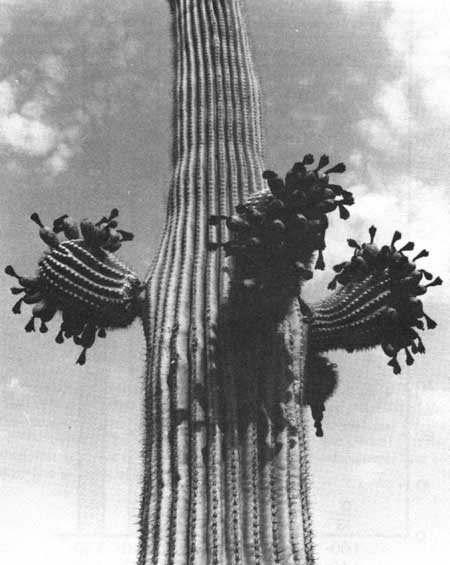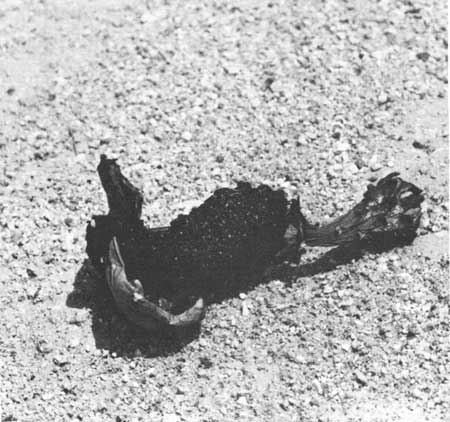|
SAGUARO
Ecology of the Saguaro: II NPS Scientific Monograph No. 8 |

|
CHAPTER 2:
REPRODUCTIVE GROWTH (continued)
Reproductive Potential
Reproductive growth of a healthy saguaro begins when the plant is approximately 2.2 m (7.2 ft) tall (Table 4; Figs. 15A, 16). The first blooming may result in the production of only one or two fruits. The number of fruits increases rapidly, however, in succeeding years, and production commonly exceeds 100 fruits per year by the time the plant has attained a height of 4.5 m (14.8 ft) (Table 3; Fig. 13). At that time, the first arm buds develop on vigorous individuals. As early as the third spring thereafter, when they have attained a length and diameter of about 15 cm (5.8 inches), the spherical arms begin to produce fruits (Fig. 15B).
|
Reproductive structures | |||||||
| Height Class (m) |
Flats |
Rocks |
Total | ||||
| Present | Absent | Present | Absent | Present | Absent | % | |
| 1.00—1.49 | 0 | 3 | 0 | 13 | 0 | 16 | 0.0 |
| 1.50—1.99 | 2 | 6 | 3 | 15 | 5 | 21 | 15.4 |
| 2.00-2.49 | 1 | 1 | 4 | 4 | 5 | 5 | 50.0 |
| 2.50—2.99 | 5 | 0 | 4 | 0 | 9 | 0 | 100.0 |
| 3.00—3.49 | 2 | 0 | 7 | 0 | 9 | 0 | 100.0 |
| 3.50—3.99 | 6 | 0 | 5 | 0 | 11 | 0 | 100.0 |
| Total | 16 | 10 | 23 | 32 | 39 | 42 | |

|
| Fig. 15A. Reproductive growth of a saguaro begins when the plant is approximately 2.2 m (7.2 ft) tall (see Fig. 16). The first blooming commonly results in the production of only one or two fruits. The production of fruits increases rapidly in succeeding years and commonly exceeds 100 fruits per year by the time the plant has attained a height of 4-5 m (13.1-16.4 ft). Photographed 17 July 1973. |

|
|
Fig. 15B. Five small arms produced 113
of the total annual crop of 182 fruits on this 5-m (16.4-ft) saguaro.
During the fourth spring after their first appearance, three visible
30-cm (12-inch) arms bear a total of 103 ripening fruits. Two third-year
arms behind (16 and 8 cm; 0.5 and 0.6 ft) produced an additional four
and six fruits, respectively. Arm buds emerge during the summer growth period when the plants have attained a stem height of 4-5 m (13.1-16.4 ft) or more. Reproductive growth on arms has been observed the third spring thereafter when the arms have attained a diameter of about 15 cm (5.8 inches). The function of arms on the saguaro is to increase the number of fruits, and hence the number of seeds, produced by the plant. Photographed 25 Jun 1974. |

|
|
Fig. 16. Heights and percentage of
saguaros with reproductive structures (buds, flowers, or fruits) at
Saguaro National Monument (west); N = 81. The sample includes all plants
1-4 m (3.3-13.1 ft) tall in transects in flat habitat (20 X 700 m; 66 X
2297 ft, N = 26) and rocky habitat (20 X 350 m; 66 X 1148 ft, N = 55).
The numbers above each bar are the reproductive (upper number) and
nonreproductive plants (lower number) in each height class. In this population the approximate mean height at the age of the first flowering is 2.25 m (7.4 ft). Data in Table 4. |
The number of fruits borne on the arms increases rapidly in succeeding years. The function of arms on the saguaro is to increase the number of fruits, and hence, the number of seeds produced by the plant.
Mature fruits weigh about 50 g (1.8 oz) each and contain approximately 2250 seeds (Table 5; Fig. 17). Under natural field conditions at Saguaro National Monument, the authors have obtained up to 60% germination success from broadcast seeds. Under controlled conditions, seed viability closely approaches 100%. Heit (1970) obtained 98% germination of wild Arizona seeds in the laboratory (14 days) with alternating daily temperatures (20-30°C; 68-86°F) and exposure to light (8 hr per day) with seeds in closed dishes and a uniform moisture supply. McDonough (1964) obtained similarly high germination percentages of 90-100% with fresh seeds and noted the lower values reported by Alcorn and Kurtz (1959).
| Measurement | Mean (± SE) | Range | 95% Confidence limits |
| Whole fruits | |||
| Length (mm) | 70.28 ± 1.99 | 57—83 | 63.97—76.59 |
| Max. Dia. (mm) | 38.39 ± 0.52 | 34—43 | 37.30—39.48 |
| Volume (cc) | 52.22 ± 1.95 | 36—64 | 48.09—53.31 |
| Weight (g) | 52.55 ± 1.91 | 37.09—63.99 | 48.51—56.59 |
Seeds per fruit (air-dry) | |||
| Weight (g) | 3.01 ± 0.15 | 1.79—3.89 | 2.69—3.33 |
| Numbera | 2263.00 ± 108 | 1488—3124 | 2035—2490 |
aBased on 100% count of seeds from 2 fruits and 200 seed samples from the remaining 16 fruits. | |||

|
| Fig. 17A. Ripe saguaro fruit; seed mass drying in open receptacle with dried flower still attached. The receptacle splits open upon ripening, exposing the sugary, bright red matrix containing the small black seeds (see Fig. 17B). Photographed 15 July 1974. |

|
| Fig. 17B. Seeds from a single saguaro fruit. A common dressmaker's pin (lower left) provides scale. Each seed is about 1.5 mm (0.06 inch) long and weighs approximately 1.3 mg (0.02 grain). An average size saguaro fruit during an average year contains 2000-2500 seeds. Photographed 15 July 1974. |
According to Shreve (1931b), the saguaro begins reproductive growth at age 50-75 years—a conservative estimate, see Tables 4 and 28—and lives 150-175 years. Based on an estimated average production of 200 fruits per year, a healthy saguaro produces a total of 40 million viable seeds during its 100-year reproductive life span. Saguaro populations at Saguaro National Monument and elsewhere in the Tucson area are characterized by high densities of reproductive saguaros (Gill and Lightle 1942; Alcorn and May 1962; Niering et al. 1963). In bajada stands at Saguaro National Monument, Niering et al. (1963) reported densities of reproductive size saguaros (plants greater than 2 m ht; 6.6 ft) of 101 stems/ha (2.5 acres) in the east monument, and 154 stems/ha in the west monument.
Assuming an average annual productivity of 200 fruits per plant (Thackery and Leding 1929), the annual reproductive potential of the east monument stand is 40.4 million seeds/ha (2.5 acres) and for the west monument, 61.6 million seeds/ha (2.5 acres). It is evident that the heretofore reported sparsity of young saguaros in these stands cannot be attributed to a lack of viable seeds.
| <<< Previous | <<< Contents >>> | Next >>> |
chap2b.htm
Last Updated: 21-Oct-2005